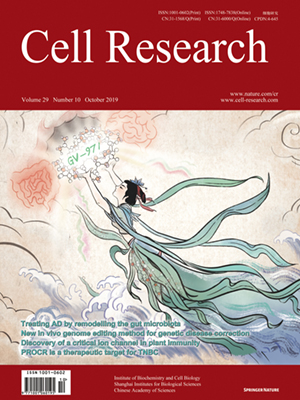
Volume 29, No 10, Oct 2019
ISSN: 1001-0602
EISSN: 1748-7838 2018
impact factor 17.848*
(Clarivate Analytics, 2019)
Volume 29 Issue 10, October 2019: 862-865
LETTERS TO THE EDITOR
Optogenetic gene editing in regional skin
Fei Li 1,2, Zhiwei Lu 1,2, Wenbo Wu 2, Nannan Qian2,Fengchao Wang2 and Ting Chen 2,3
1Graduate School of Peking Union Medical College, Beijing 100871,China; 2National Institute of Biological Sciences, Beijing 102206, China and 3Tsinghua Institute of Multidisciplinary Biomedical Research, Tsinghua University, Beijing 100871, China
These authors contributed equally: Fei Li, Zhiwei Lu
Correspondence: Ting Chen (chenting@nibs.ac.cn)
Dear Editor,
Significant breakthrough in science often relies on the development of original tools that can perform novel functions, thus help reveal previously unknown knowledge that is not feasible to obtain using conventional tools or methods. Genetic manipulation has become a standard practice in almost all biological research fields; consequently gene expression control systems such as Cre and rtTA are indispensable tools for biomedical studies.1,2 Inducible systems of the standard gene regulation tools are controlled by addition of freely diffusible small molecules such as an antibiotic or a steroid analogue.1,2,3 However, the growing complexity of scientific research requires the development of more precise gene regulation systems that can spatiotemporally control gene expression in a tunable and reversible manner. In comparison to chemical agents, light is an ideal inducer of gene expression in a spatiotemporal specific manner. Optogenetic tools have revolutionized the studies in neuroscience and are quickly changing the standard practice in many other fields.4,5,6,7,8,9 These systems utilize light sensitive proteins to facilitate spatiotemporal protein activation, localization or genetic alterations. However, most of the light-controlled gene regulation systems were established and applied in vitro, while in vivo light switchable gene regulation system still remains a major unmet biomedical research need. A novel optogenetic mouse system that could enable spatiotemporal gene manipulations in vivo will facilitate novel discoveries.
https://doi.org/10.1038/s41422-019-0209-9
FULL TEXT | PDF
Browse 1110


